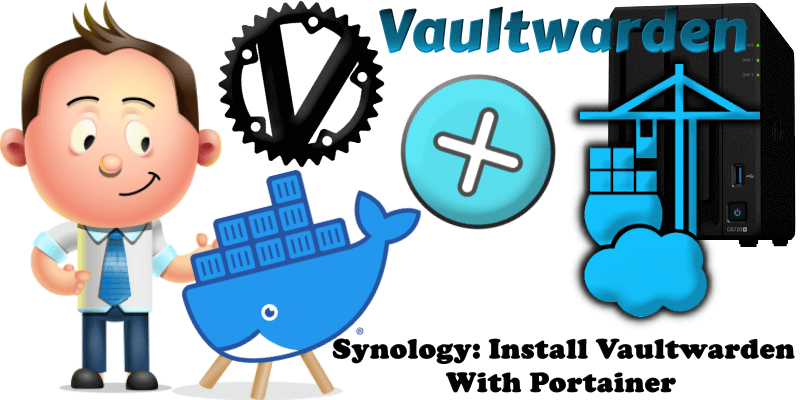
My previous guide for Vaultwarden involved the use of Task Scheduler, but today I’m offering a recommended and excellent alternative for installing Vaultwarden via Portainer. Vaultwarden is an unofficial Bitwarden server implementation written in Rust. Vaultwarden is compatible with the official Bitwarden clients, and is ideal for self-hosted deployments where running the official resource-heavy service is undesirable. Note: If you want to Install the official Bitwarden, check out my new article on How to Install Bitwarden on Your Synology NAS. In this step by step guide I will show you how to install Vaultwarden on your Synology NAS using Docker & Portainer.
STEP 1
Please Support My work by Making a Donation.
STEP 2
Install Portainer using my step by step guide. If you already have Portainer installed on your Synology NAS, skip this STEP. Attention: Make sure you have installed the latest Portainer version.
STEP 3
Make sure you have a synology.me Wildcard Certificate. Follow my guide to get a Wildcard Certificate. If you already have a synology.me Wildcard certificate, skip this STEP.
STEP 4
Go to Control Panel / Login Portal / Advanced Tab / click Reverse Proxy. Follow the instructions in the image below.
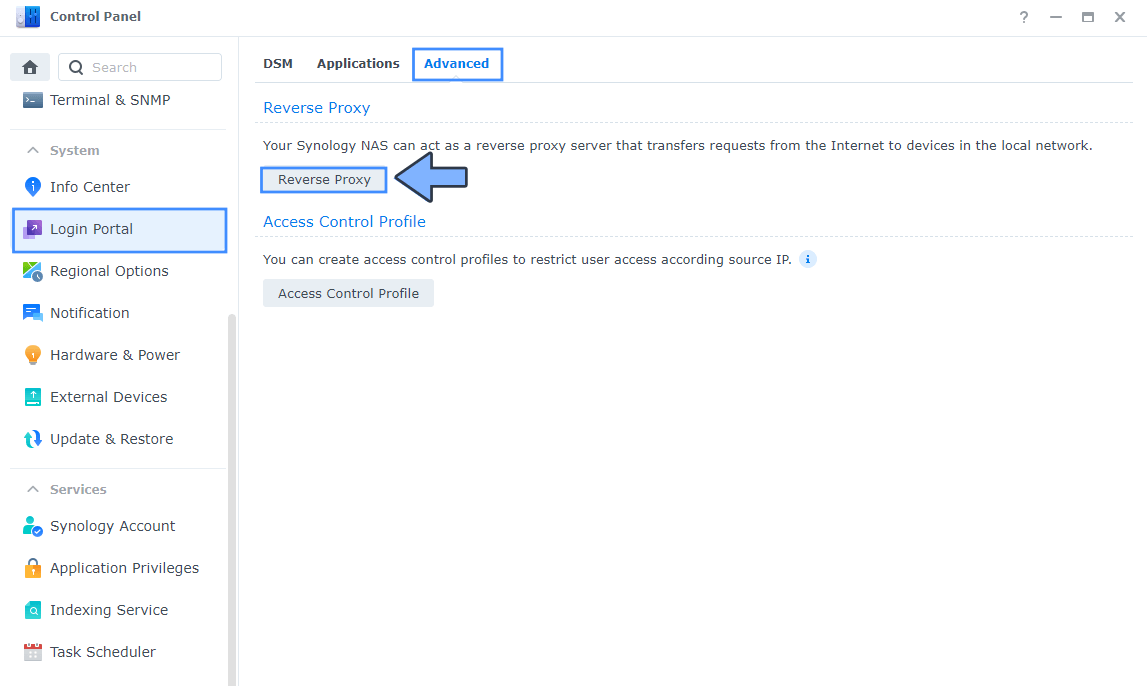
STEP 5
Now click the “Create” button. Follow the instructions in the image below.
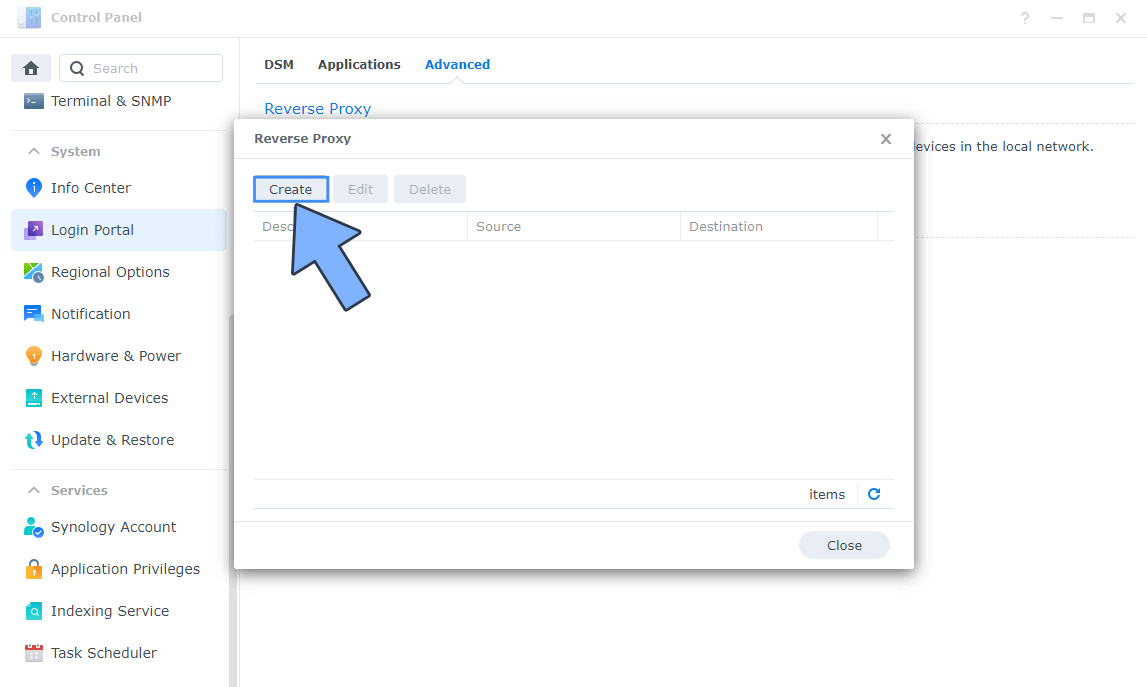
STEP 6
After you click the Create button, the window below will open. Follow the instructions in the image below.
On the General area, set the Reverse Proxy Name description: type in Vaultwarden. After that, add the following instructions:
Source:
Protocol: HTTPS
Hostname: vaultwarden.yourname.synology.me
Port: 443
Check Enable HSTS
Destination:
Protocol: HTTP
Hostname: localhost
Port: 4080
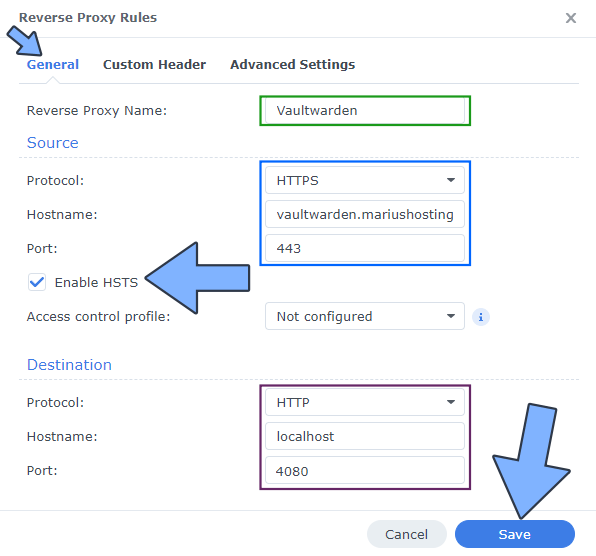
STEP 7
On the Reverse Proxy Rules, click the Custom Header tab. Click Create and then, from the drop-down menu, click WebSocket. After you click on WebSocket, two Header Names and two Values will be automatically added. Click Save. Follow the instructions in the image below.

STEP 8
Go to Control Panel / Network / Connectivity tab/ Check Enable HTTP/2 then click Apply. Follow the instructions in the image below.
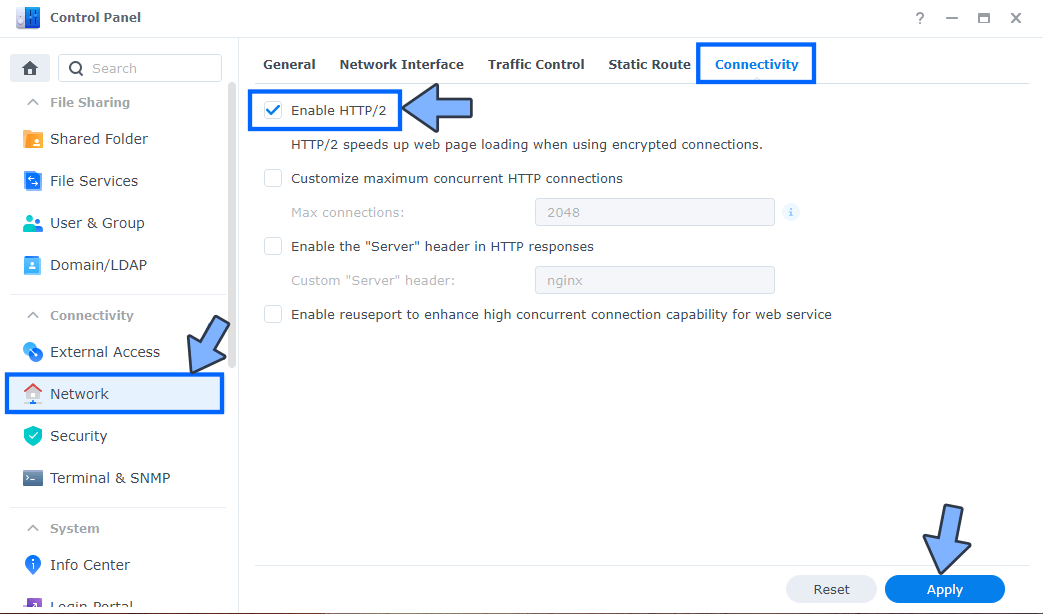
STEP 9
Go to Control Panel / Security / Advanced tab/ Check Enable HTTP Compression then click Apply. Follow the instructions in the image below.
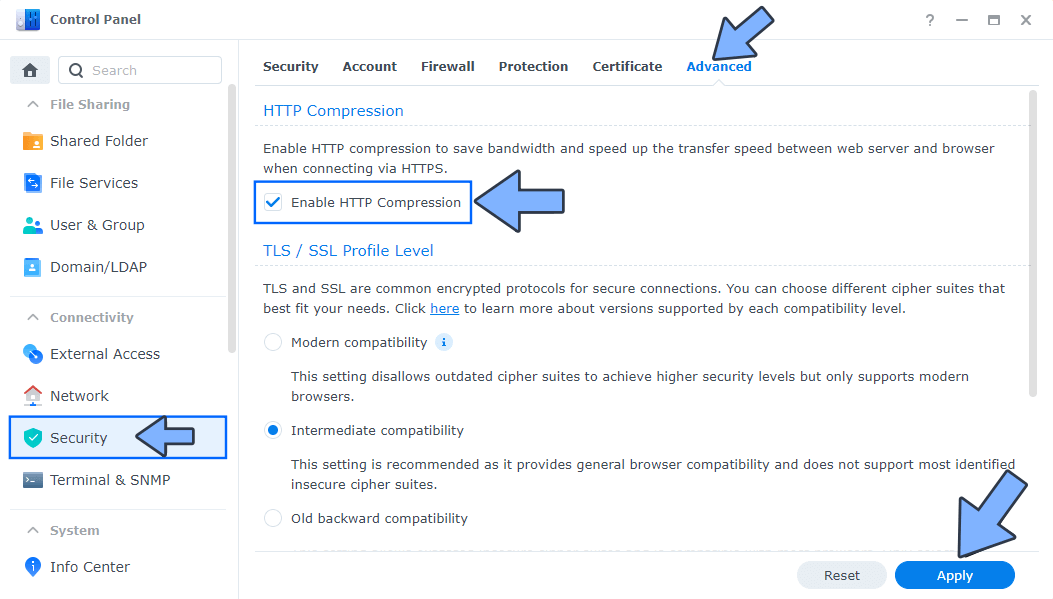
STEP 10
Go to File Station and open the docker folder. Inside the docker folder, create one new folder and name it vaultwarden. Follow the instructions in the image below.
Note: Be careful to enter only lowercase, not uppercase letters.
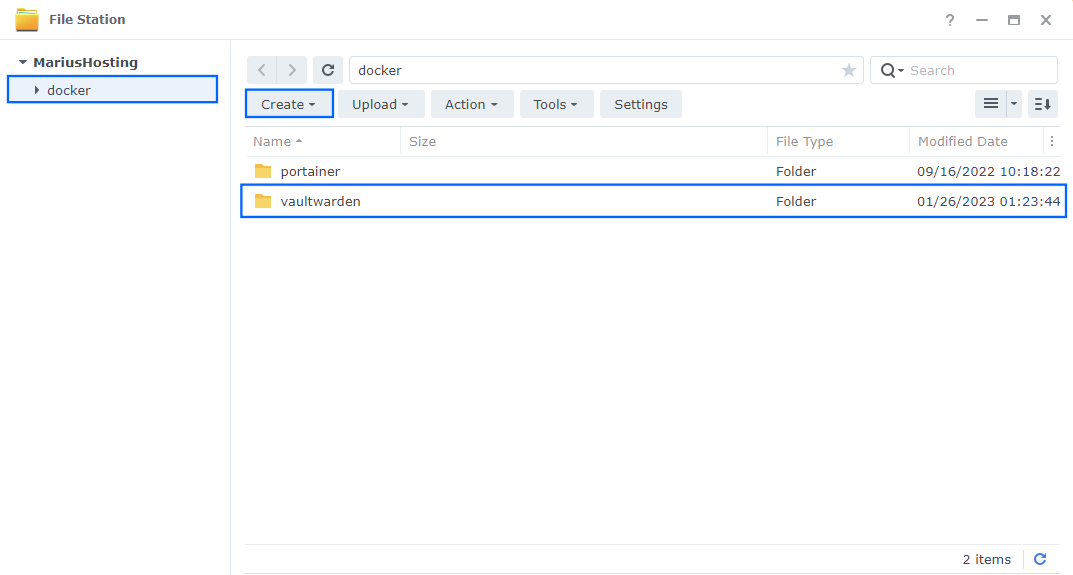
STEP 11
Now create two new folders inside the vaultwarden folder that you created at STEP 10 and name them data and db. Follow the instructions in the image below.
Note: Be careful to enter only lowercase, not uppercase letters.
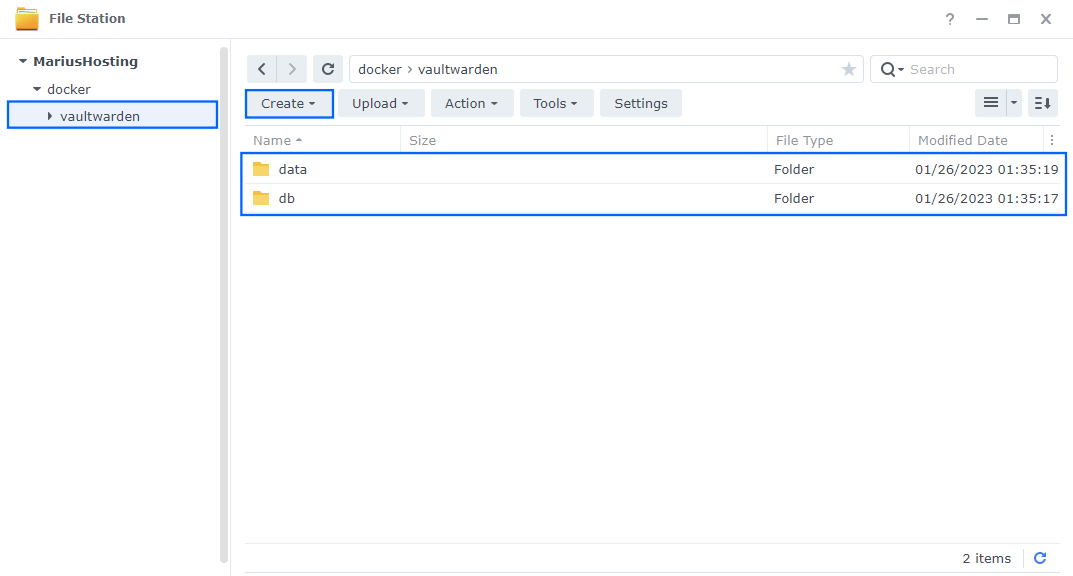
STEP 12
Follow my step by step guide on how to activate SMTP for your Gmail account. This step is mandatory. Note: If you don’t want to use the easiest way for SMTP with Google and you already have SMTP details from your own Mail Server, you can just skip this STEP and use your personalized email SMTP details instead.
STEP 13
Log into Portainer using your username and password. On the left sidebar in Portainer, click on Home then Live connect. Follow the instructions in the image below.

On the left sidebar in Portainer, click on Stacks then + Add stack. Follow the instructions in the image below.

STEP 14
In the Name field type in vaultwarden. Follow the instructions in the image below.
services:
db:
image: postgres:17
container_name: Vaultwarden-DB
hostname: vaultwarden-db
security_opt:
- no-new-privileges:true
healthcheck:
test: ["CMD", "pg_isready", "-q", "-d", "vaultwarden", "-U", "vaultwardenuser"]
timeout: 45s
interval: 10s
retries: 10
volumes:
- /volume1/docker/vaultwarden/db:/var/lib/postgresql/data:rw
environment:
POSTGRES_DB: vaultwarden
POSTGRES_USER: vaultwardenuser
POSTGRES_PASSWORD: vaultwardenpass
restart: on-failure:5
vaultwarden:
image: vaultwarden/server:latest
container_name: Vaultwarden
hostname: vaultwarden
security_opt:
- no-new-privileges:true
user: 1026:100
ports:
- 4080:4020
volumes:
- /volume1/docker/vaultwarden/data:/data:rw
environment:
ROCKET_PORT: 4020
DATABASE_URL: postgresql://vaultwardenuser:vaultwardenpass@vaultwarden-db:5432/vaultwarden
ADMIN_TOKEN: MariushostingMariushostingMari13
DISABLE_ADMIN_TOKEN: false
DOMAIN: https://vaultwarden.yourname.synology.me
SMTP_HOST: smtp.gmail.com
SMTP_FROM: Your-own-gmail-address
SMTP_PORT: 587
SMTP_SECURITY: starttls
SMTP_USERNAME: Your-own-gmail-address
SMTP_PASSWORD: Your-own-app-password
restart: on-failure:5
depends_on:
db:
condition: service_started
Note: Before you paste the code above in the Web editor area below, change the value numbers for user with your own UID and GID values. (Follow my step by step guide on how to do this.) 1026 is my personal UID value and 100 is my personal GID value. You have to type in your own values.
Note: Before you paste the code above in the Web editor area below, change the value for ADMIN_TOKEN and add your own ADMIN TOKEN. MariushostingMariushostingMari13 is an example for an ADMIN TOKEN. You should invent your own Value. Add 32 random characters, both letters and numbers.
Note: Before you paste the code above in the Web editor area below, change the value for DOMAIN and type in your own synology.me DDNS with https:// at the beginning that you have previously created at STEP 6.
Note: Before you paste the code above in the Web editor area below, change the value for SMTP_FROM and type in your own Gmail address. STEP 12.
Note: Before you paste the code above in the Web editor area below, change the value for SMTP_USERNAME and type in your own Gmail address. STEP 12.
Note: Before you paste the code above in the Web editor area below, change the value for SMTP_PASSWORD and type in your own Gmail app password. STEP 12.
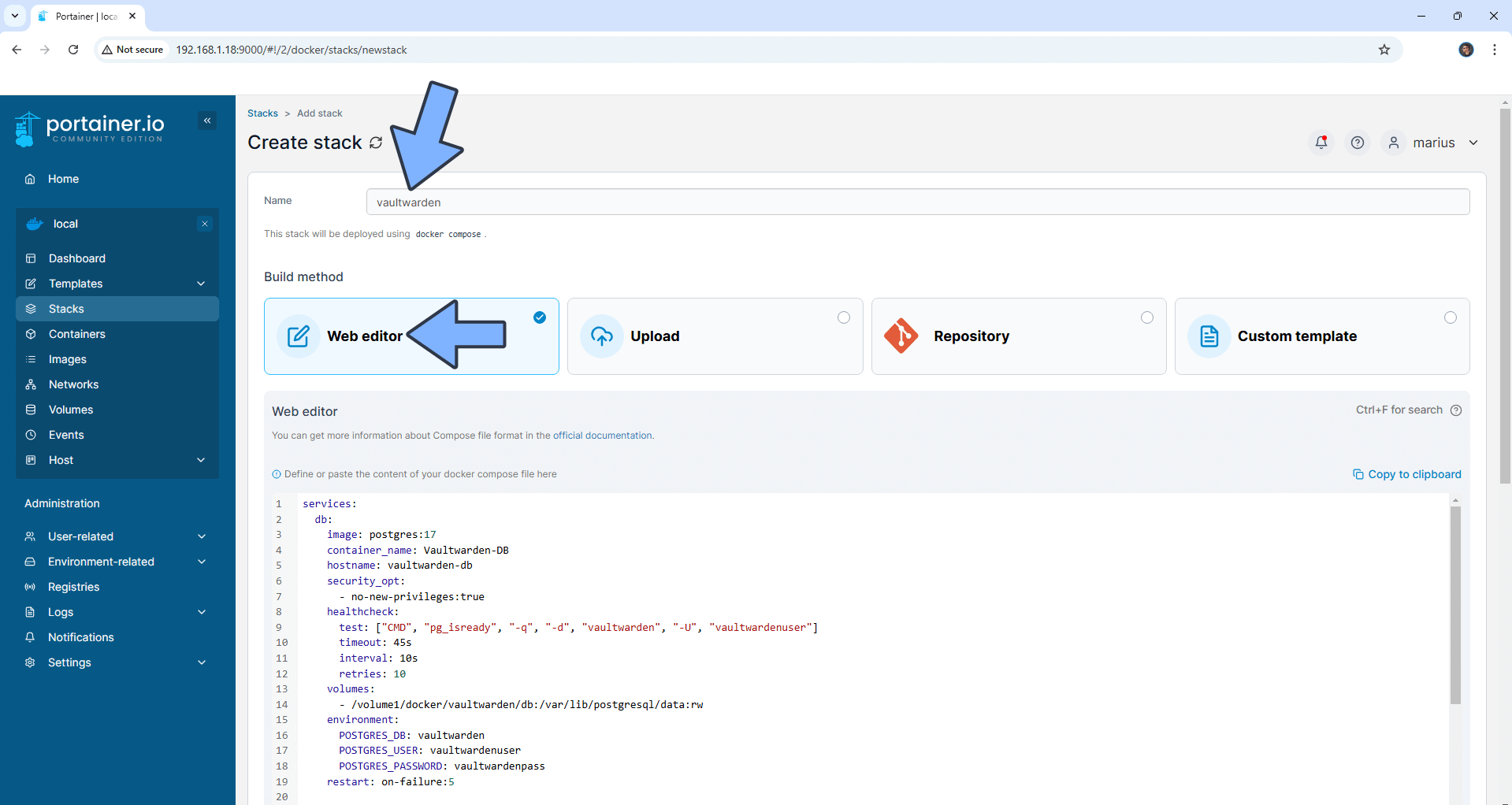
STEP 15
Scroll down on the page until you see a button named Deploy the stack. Click on it. Follow the instructions in the image below. The installation process can take up to a few minutes. It will depend on your Internet speed connection.
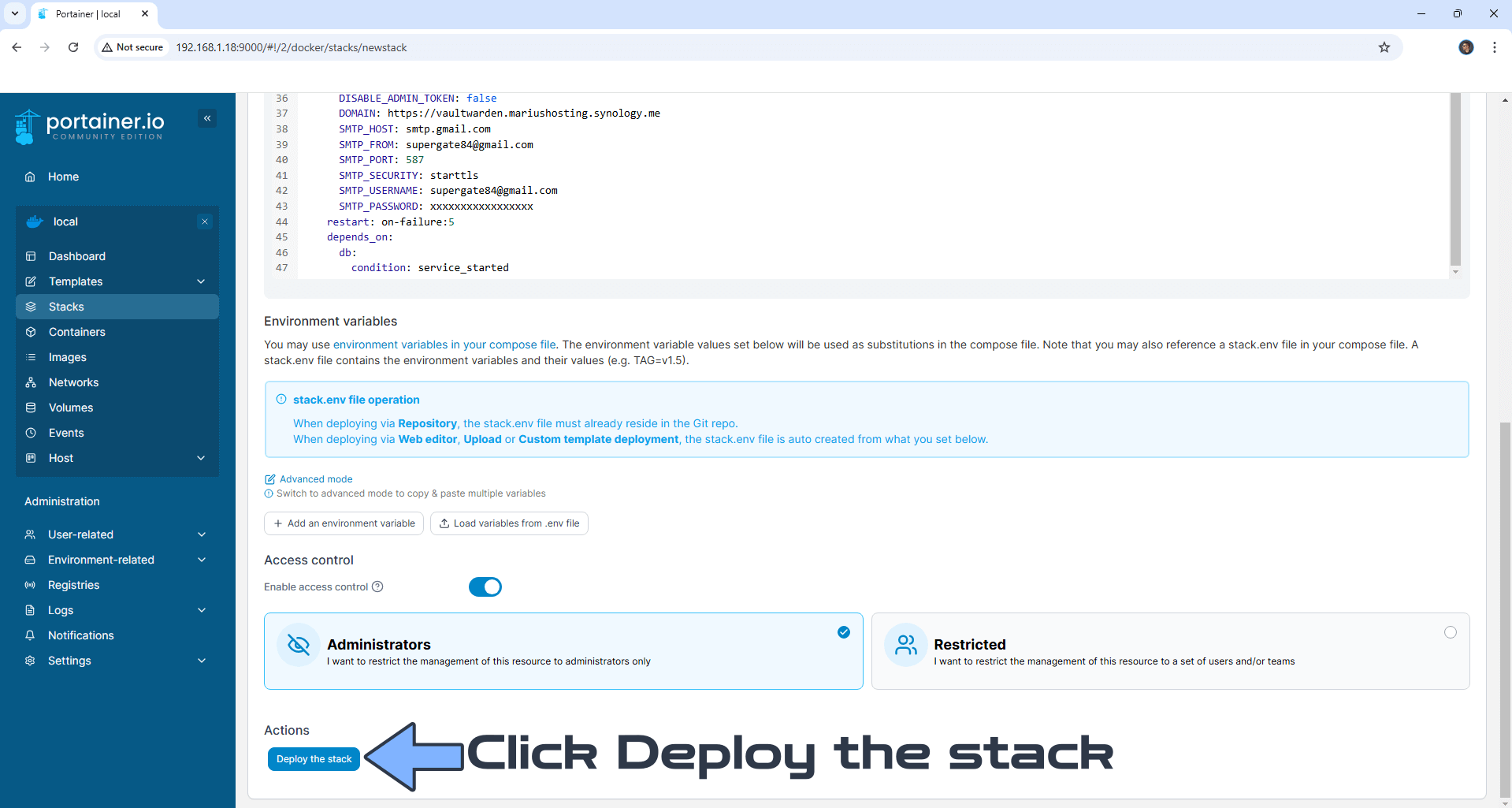
STEP 16
If everything goes right, you will see the following message at the top right of your screen: “Success Stack successfully deployed“.

STEP 17
🟢Please Support My work by Making a Donation. Almost 99,9% of the people that install something using my guides forget to support my work, or just ignore STEP 1. I’ve been very honest about this aspect of my work since the beginning: I don’t run any ADS, I don’t require subscriptions, paid or otherwise, I don’t collect IPs, emails, and I don’t have any referral links from Amazon or other merchants. I also don’t have any POP-UPs or COOKIES. I have repeatedly been told over the years how much I have contributed to the community. It’s something I love doing and have been honest about my passion since the beginning. But I also Need The Community to Support me Back to be able to continue doing this work.
STEP 18
Now open your browser and type in your HTTPS/SSL certificate like this https://vaultwarden.yourname.synology.me that you have previously created at STEP 6. In my case it’s https://vaultwarden.mariushosting.synology.me If everything goes right, you will see the Vaultwarden homepage. Click Create account. Follow the instructions in the image below.
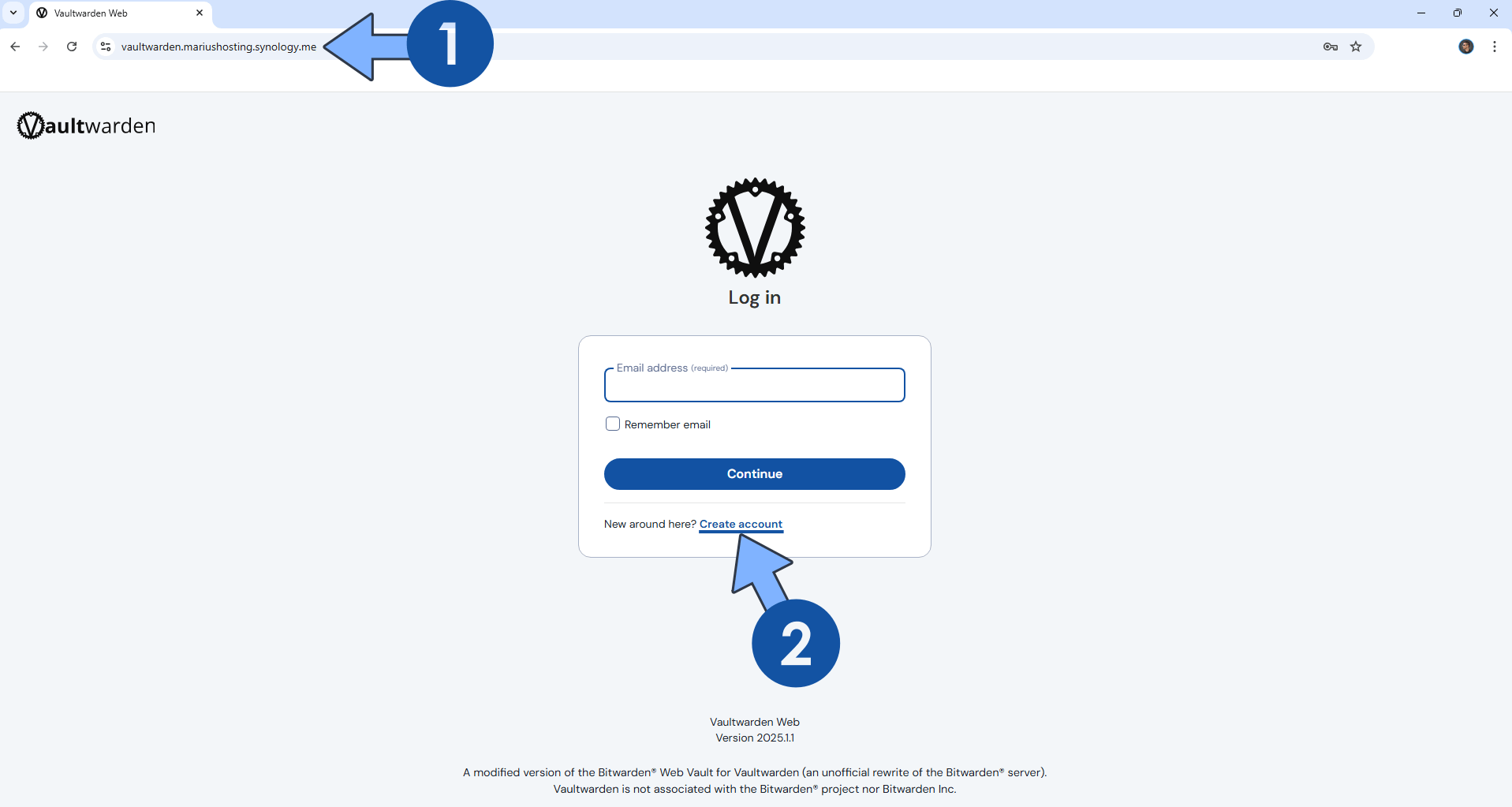
STEP 19
Type in your own Email, Name and Password, then click Create Account. Follow the instructions in the image below.
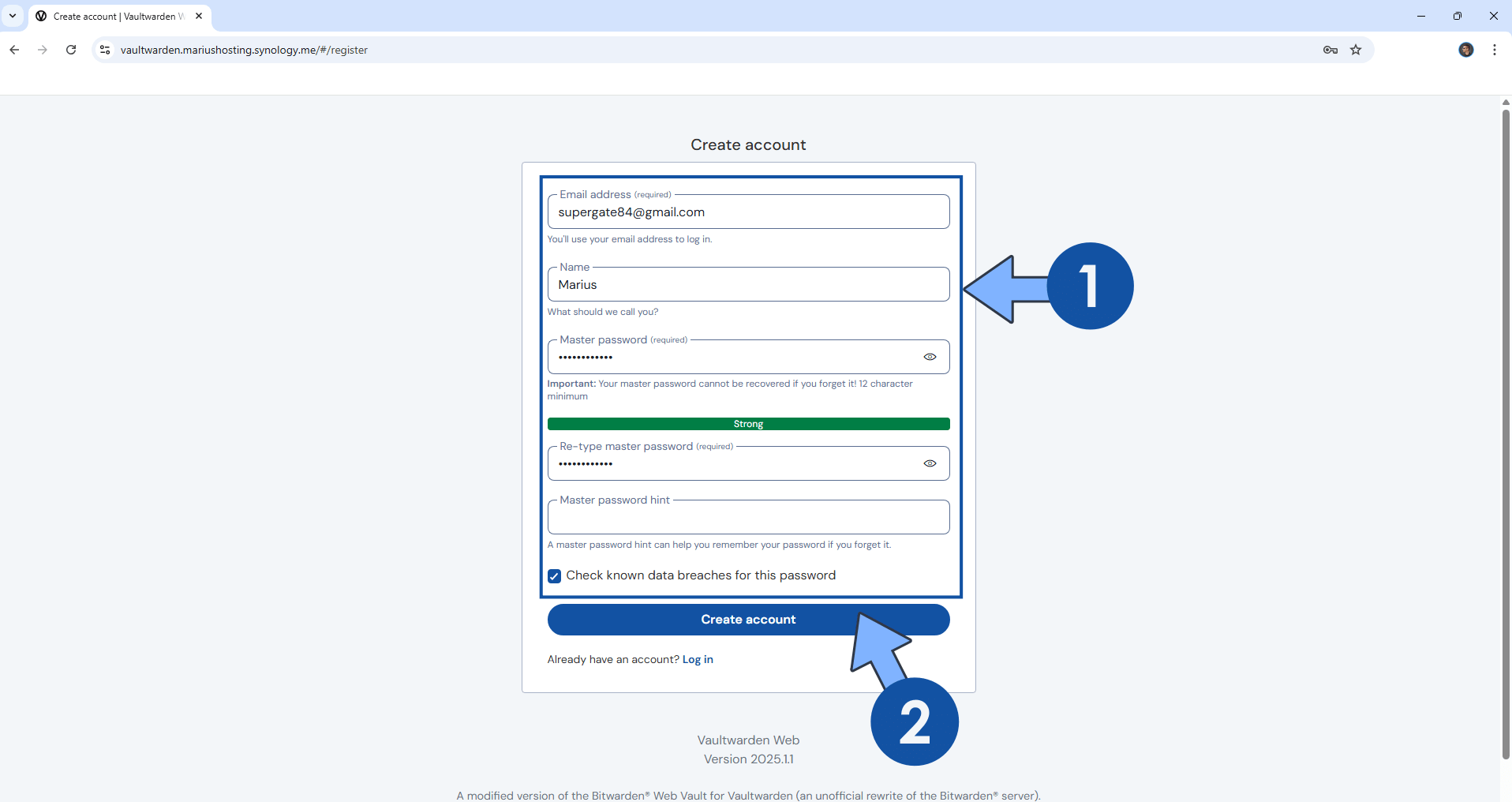
STEP 20
Your account is created! Type in your own Email that you have previously added at STEP 19, then click Continue. Follow the instructions in the image below.
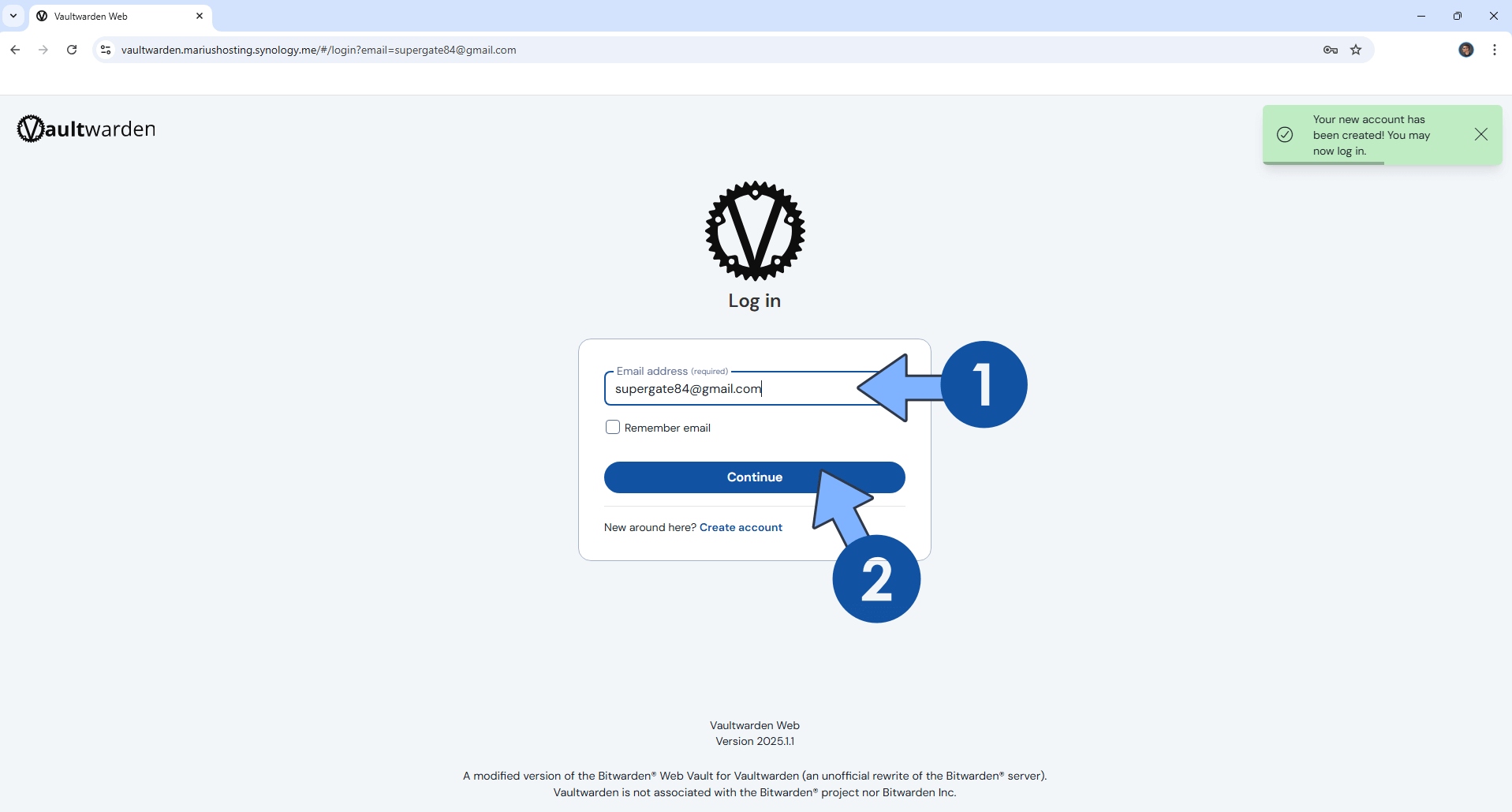
STEP 21
Your account is created! Type in your own Master password that you have previously created at STEP 19, then click Log in with master password. Follow the instructions in the image below.
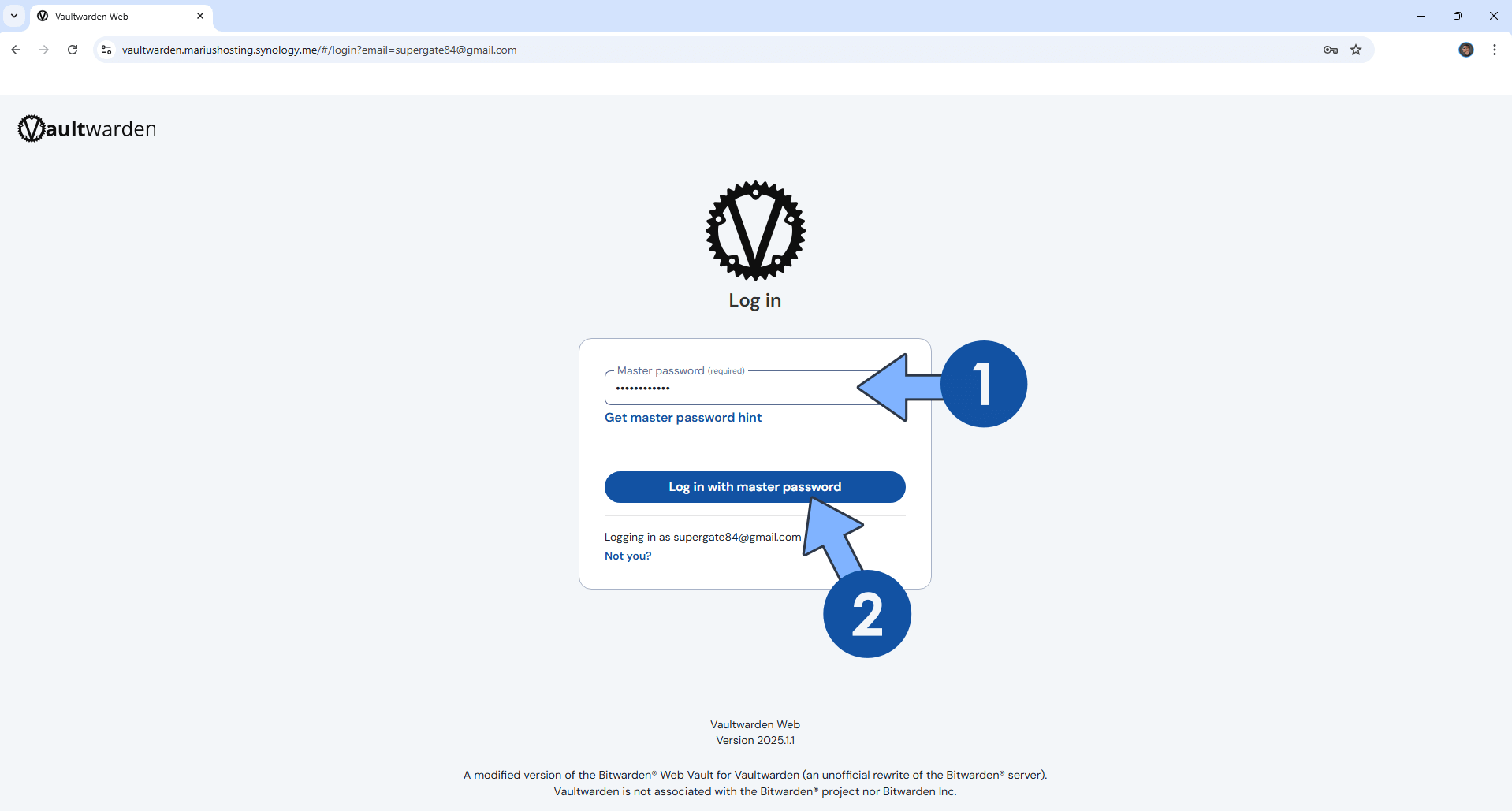
STEP 22
Once you are in your Vaults, click Send email to get a verification email. Follow the instructions in the image below.

STEP 23
Open your email then check the email that was automatically sent to you. Click on Verify Email Address Now. Follow the instructions in the image below.

STEP 24
Once the account email is verified, type in your own Email address that you have previously added at STEP 19. Click Continue. Follow the instructions in the image below.
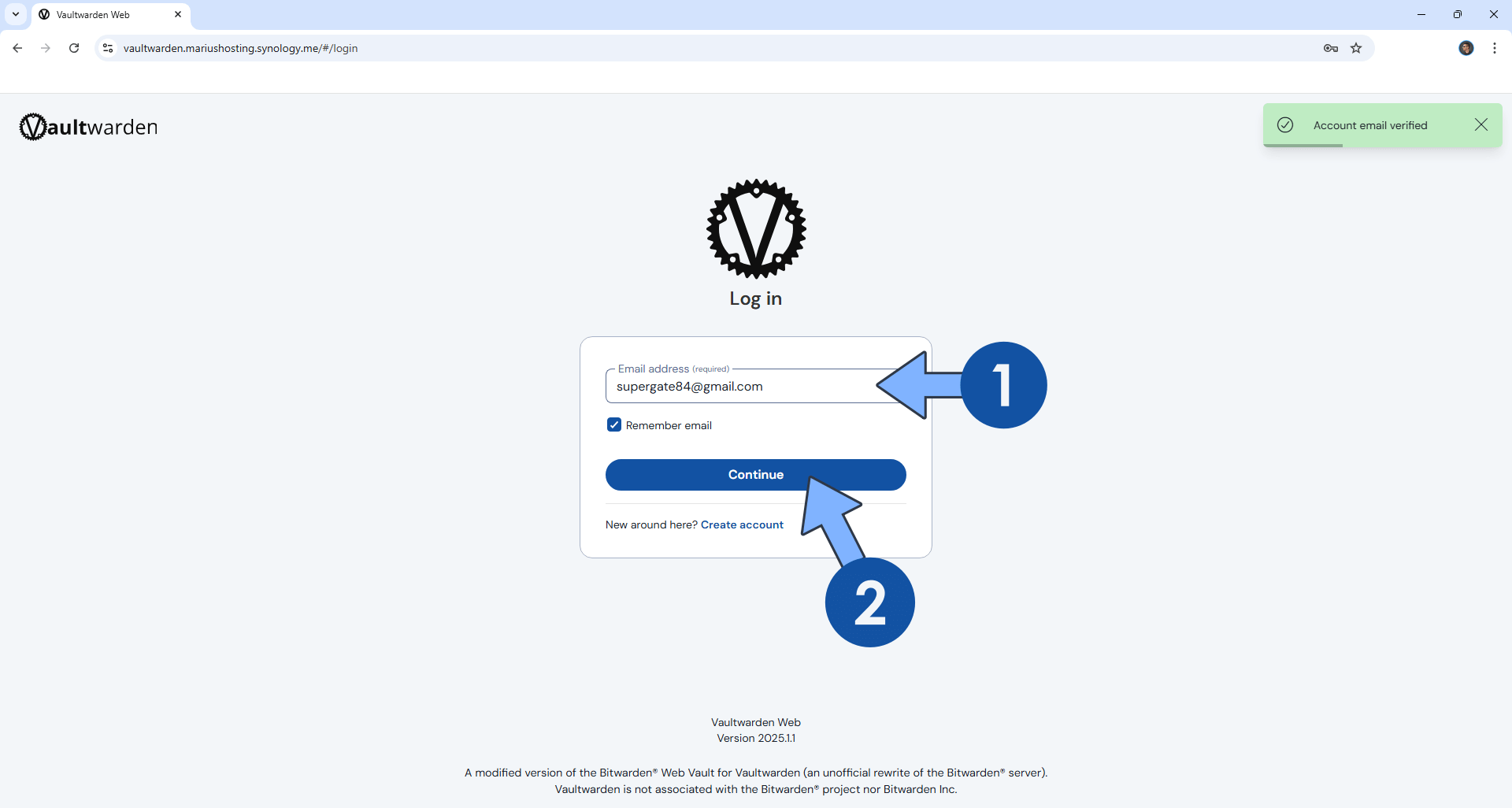
STEP 25
Type in your own Master password that you have previously added at STEP 19. Click Log in with master password. Follow the instructions in the image below.

STEP 26
Your Vaultwarden dashboard at a glance!
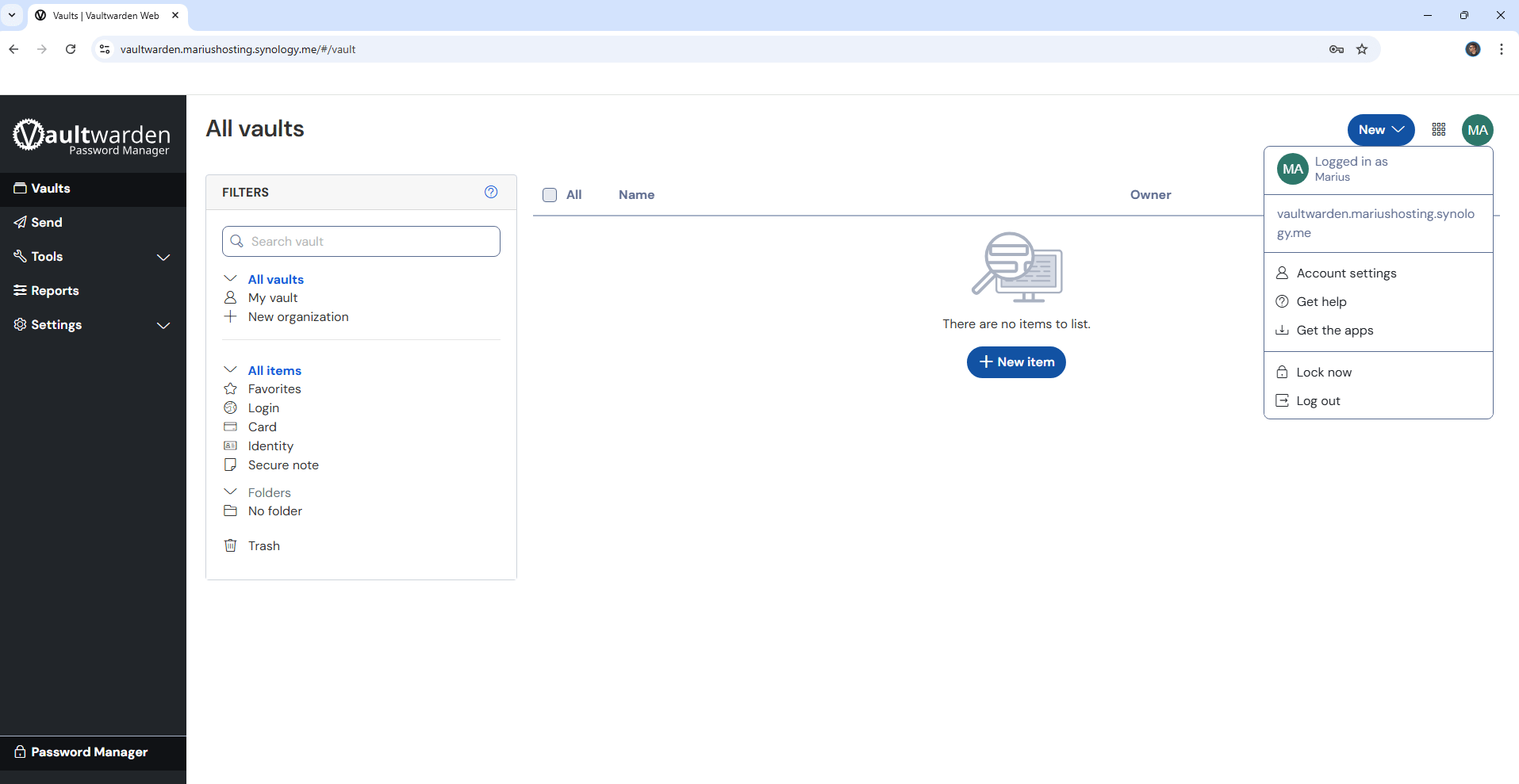
STEP 27
On the left sidebar, click Settings, then Preferences. Change the theme to Dark, then click Save. Follow the instructions in the image below.
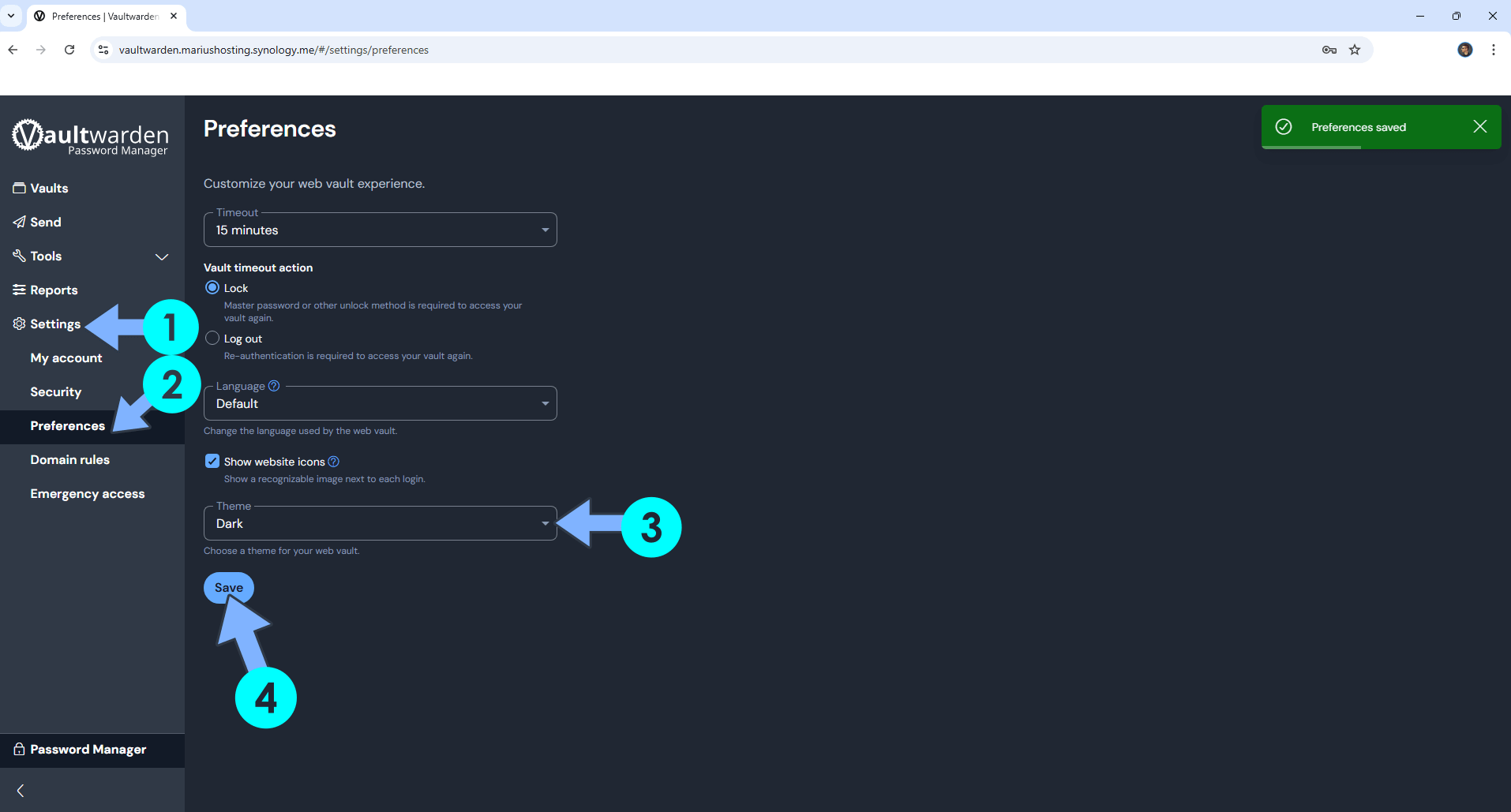
STEP 28
Now open your browser and connect to your own synology.me DDNS address, for example https://vaultwarden.yourname.synology.me/admin You will be asked for an Authentication key. Copy paste your own ADMIN_TOKEN that you have previously created at STEP 14 then click Enter. Follow the instructions in the image below.
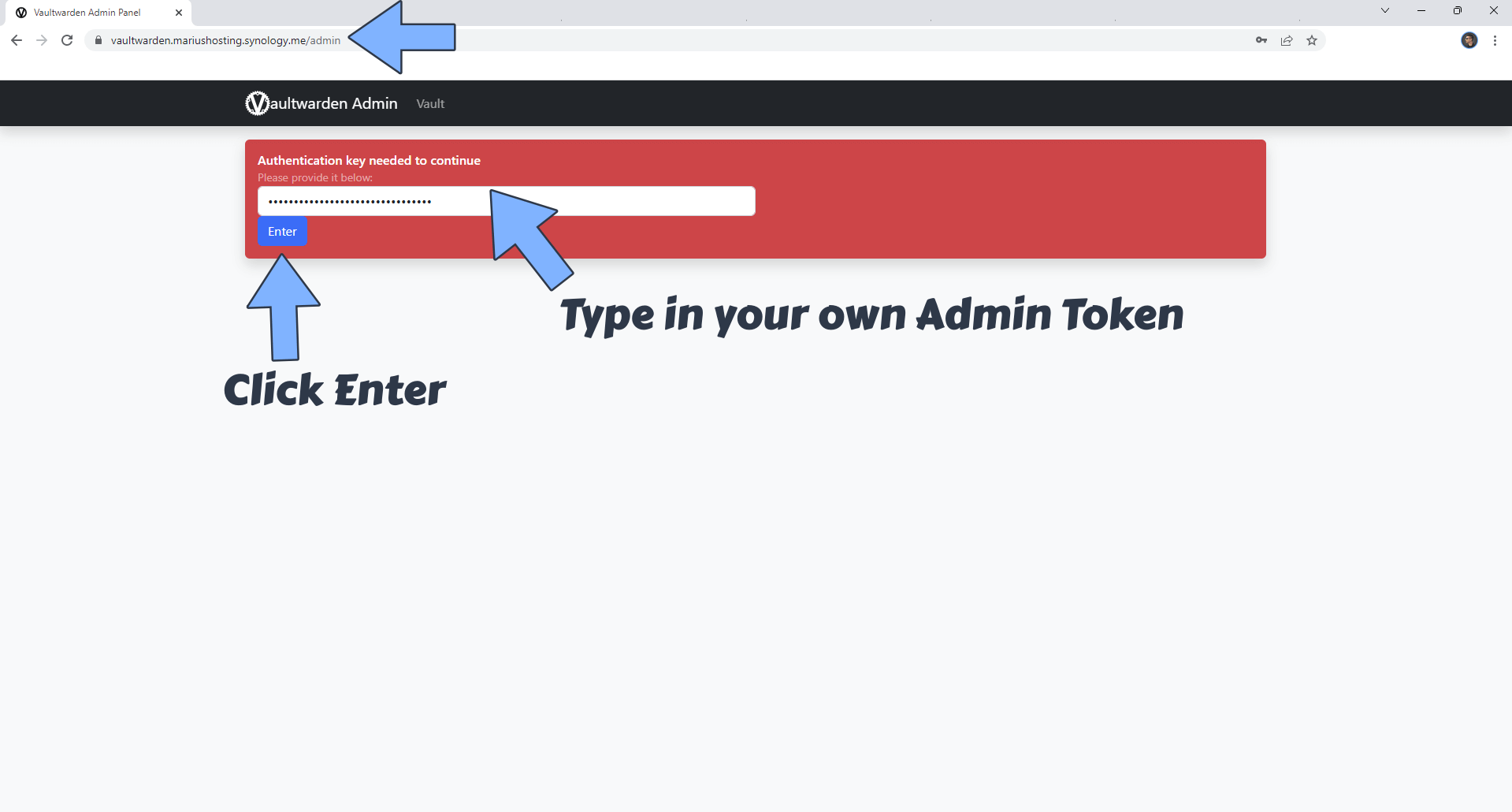
STEP 29
Click General settings. Follow the instructions in the image below.
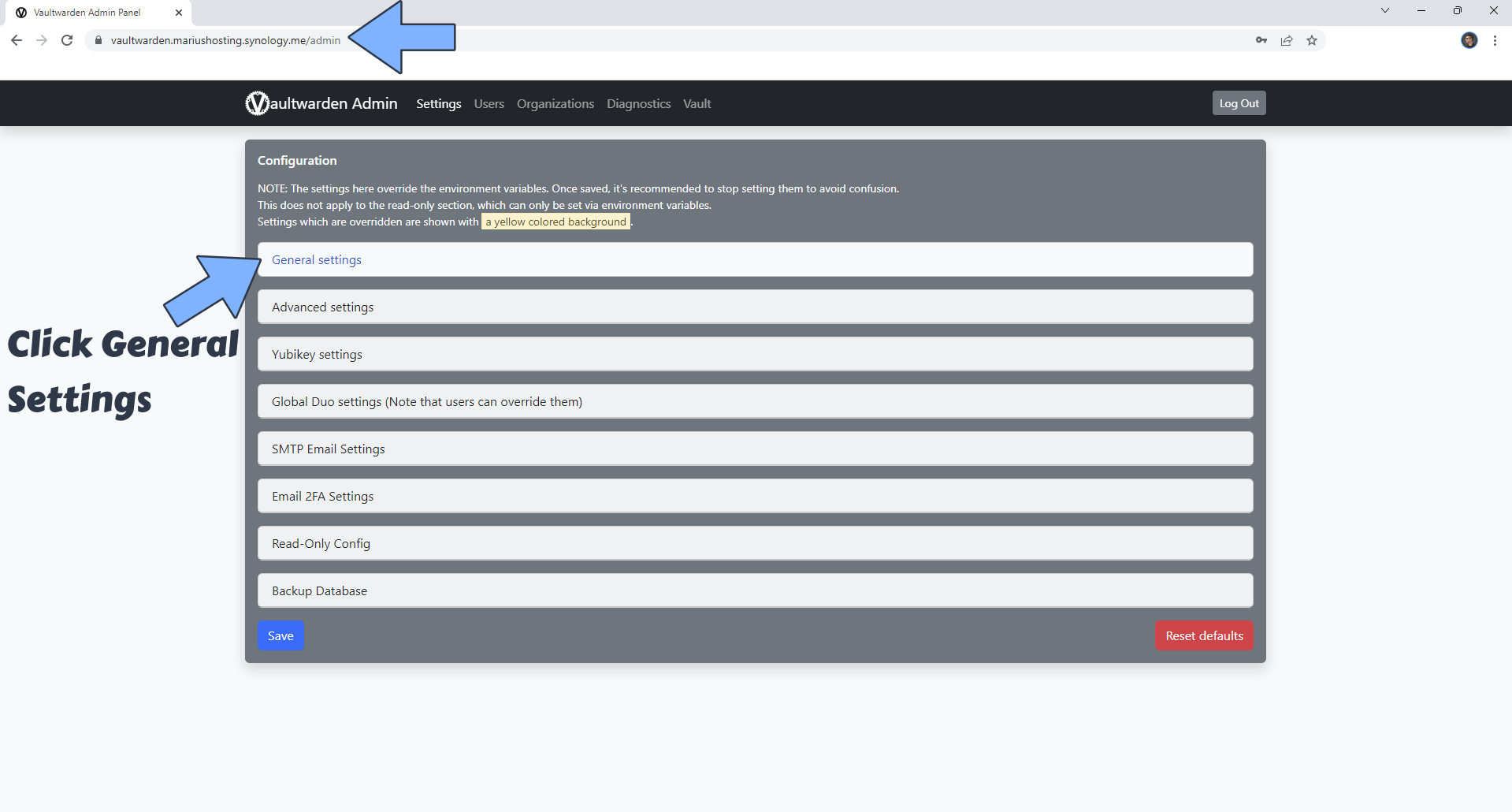
STEP 30
To disable user registration, uncheck Allow new signups. Click Save to save the settings.
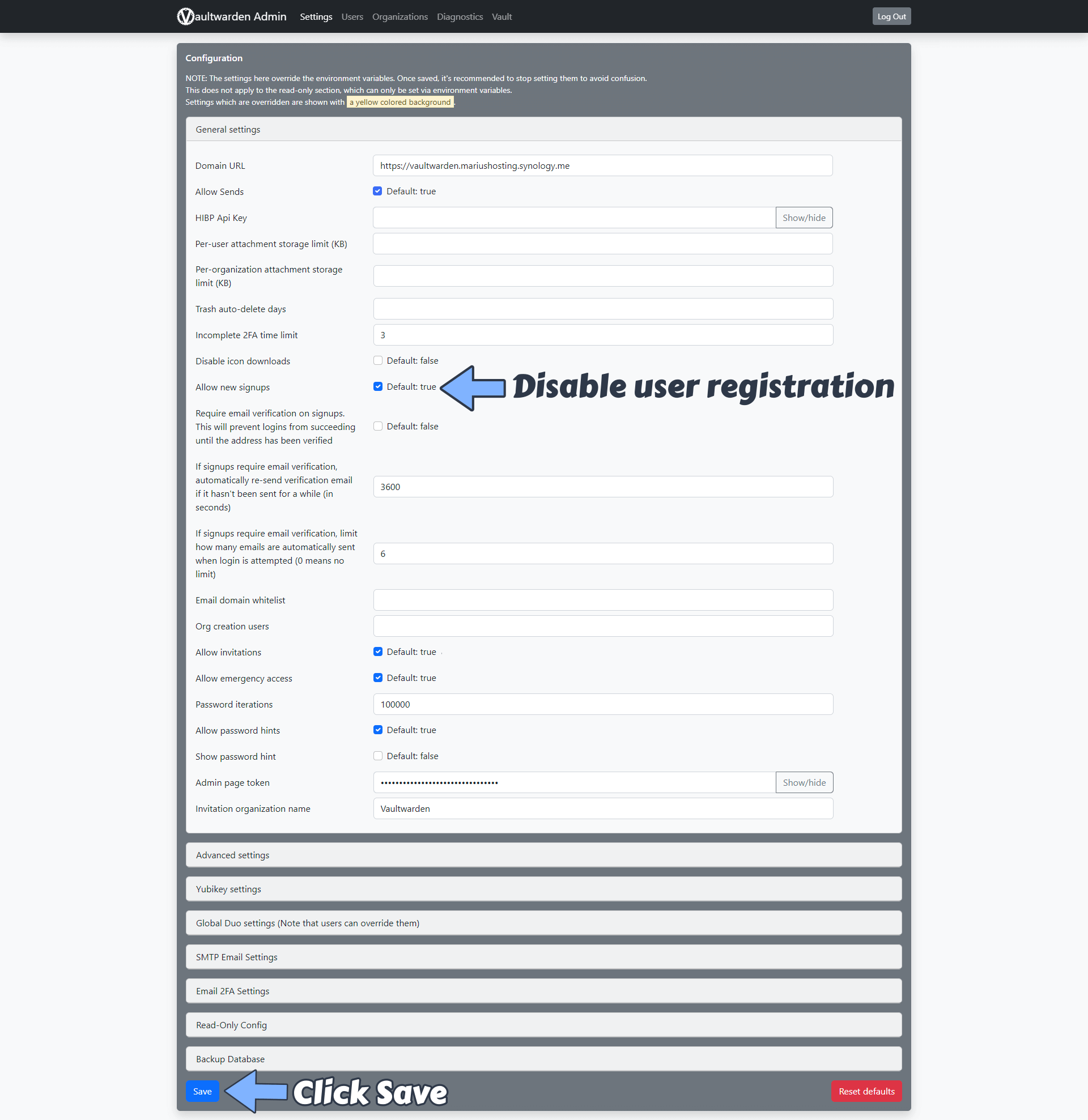
STEP 31
You can now invite your friends/family to your Vaultwarden vault.
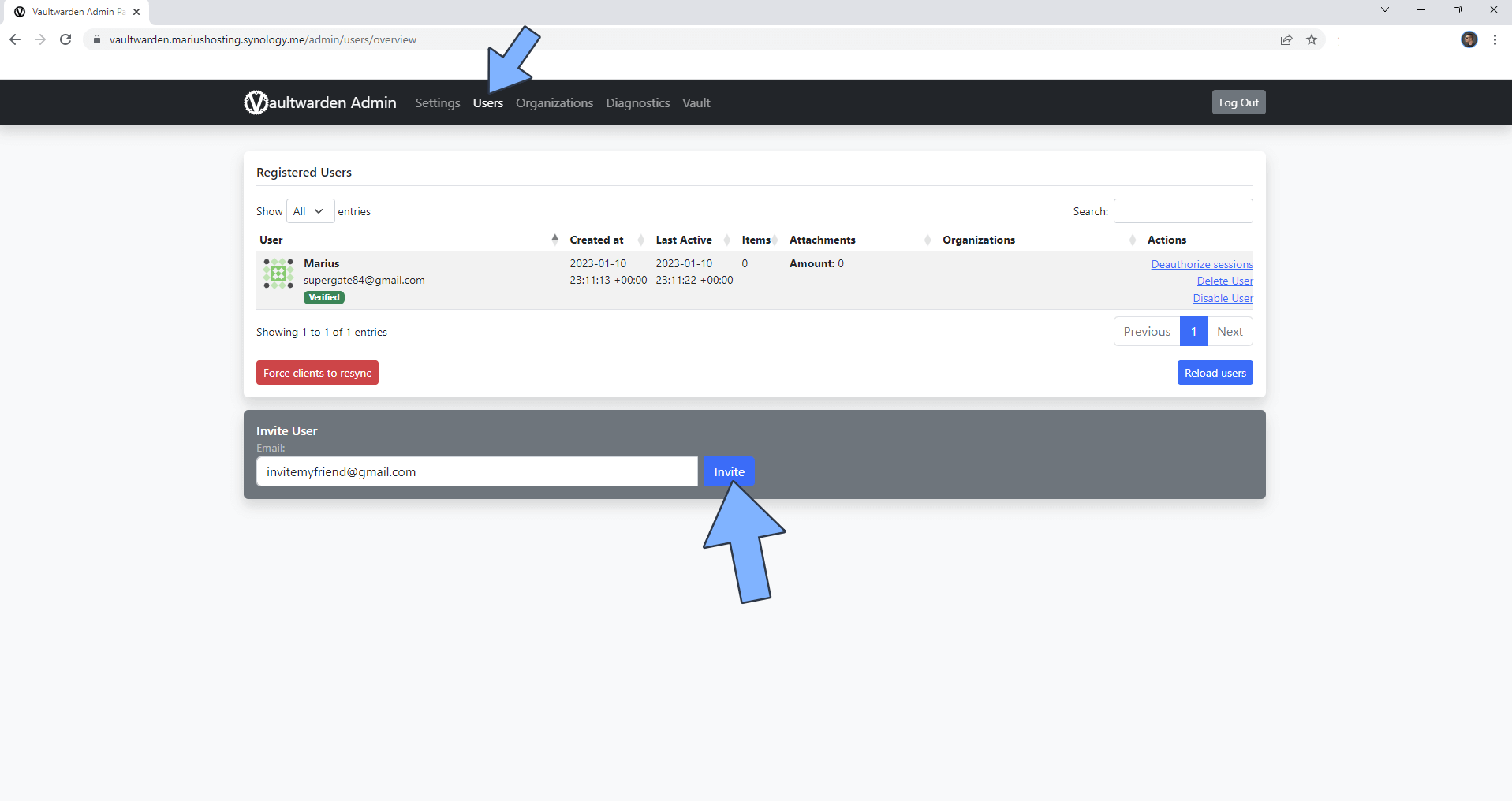
STEP 32
Starting with Vaultwarden version 1.28.0, you must have noticed that, when you log in to your Vaultwarden admin page, you get the following error message: You are using a plain text ‘ADMIN_TOKEN’ which is insecure. Please generate a secure Argon2 PHC string by using ‘vaultwarden hash’ or ‘argon2’. Go to the next STEP.

STEP 33
On the left sidebar in Portainer, click Containers. Identify your Vaultwarden instance, then click on the little terminal icon. Follow the instructions in the image below.
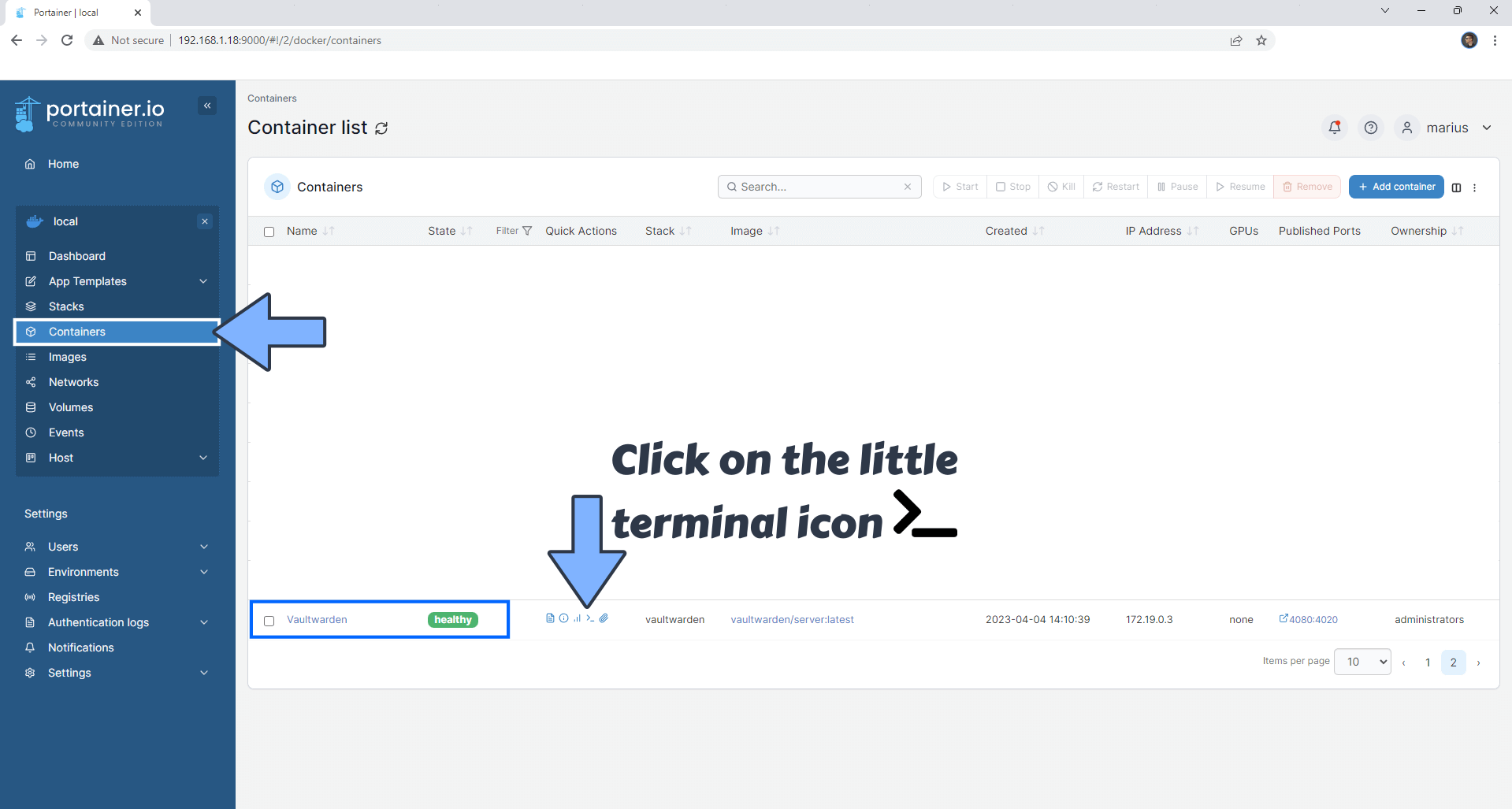
STEP 34
After you click on the little terminal icon at STEP 33, a new page will open. Click Connect. Follow the instructions in the image below.
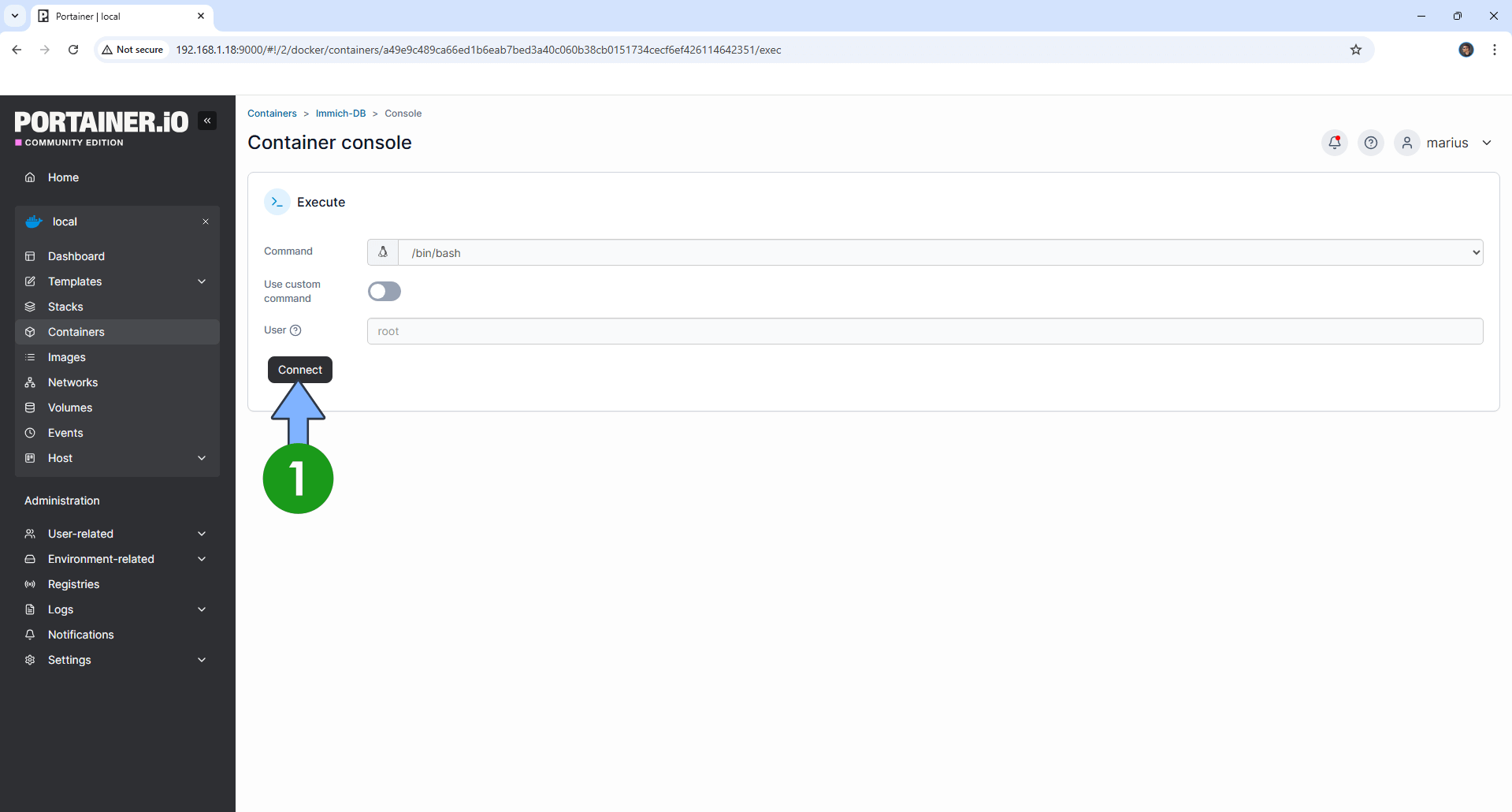
STEP 35
After you click Connect at STEP 34, a Console will open. Copy Paste the code below then press Enter on your keyboard.
/vaultwarden hash
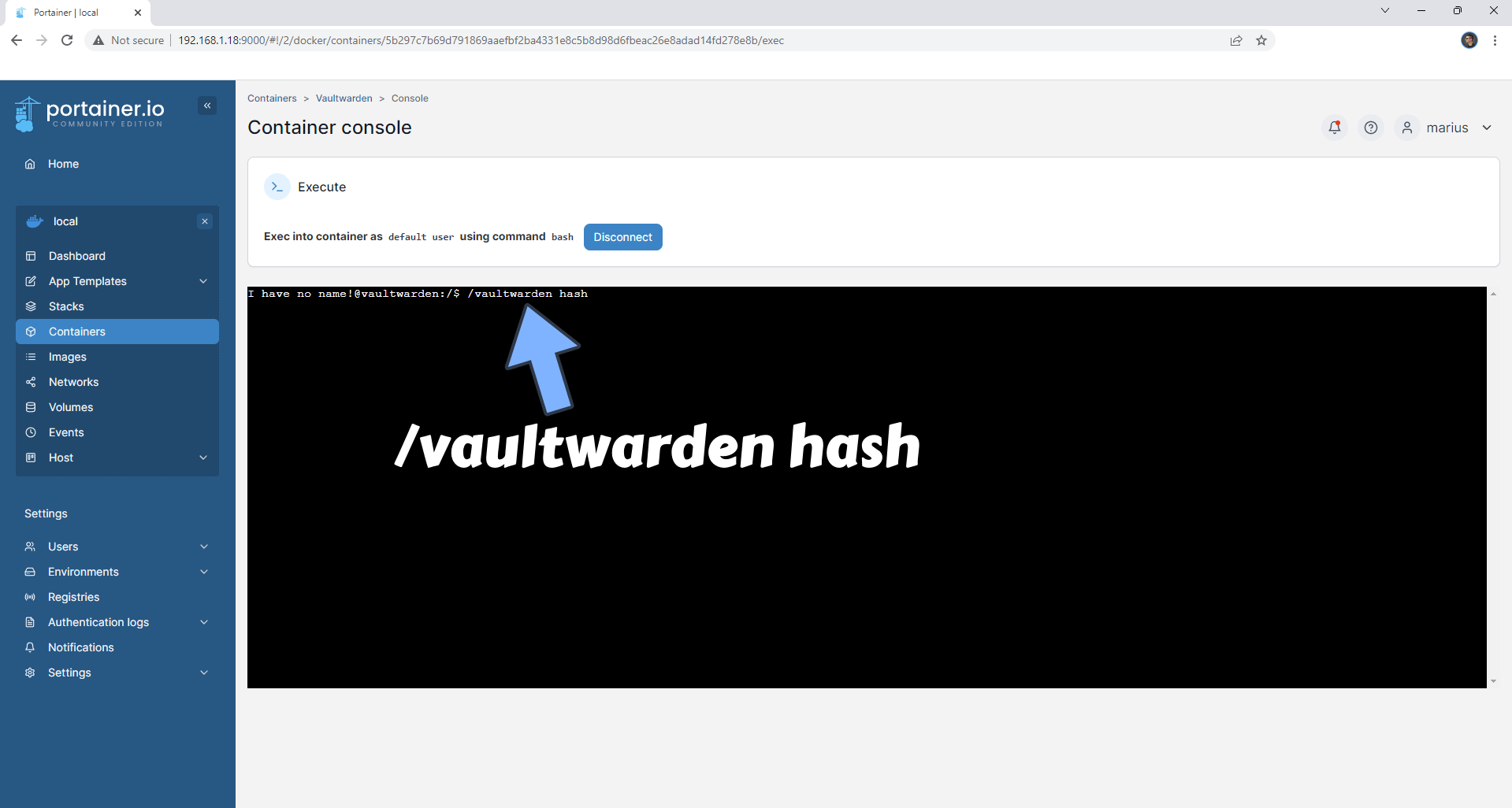
STEP 36
You will be prompted to enter a Password. Type in a password longer than 8 characters then press Enter on your keyboard. ⚠️Warning: Write down this password and save it because you will need it later. Follow the instructions in the image below.
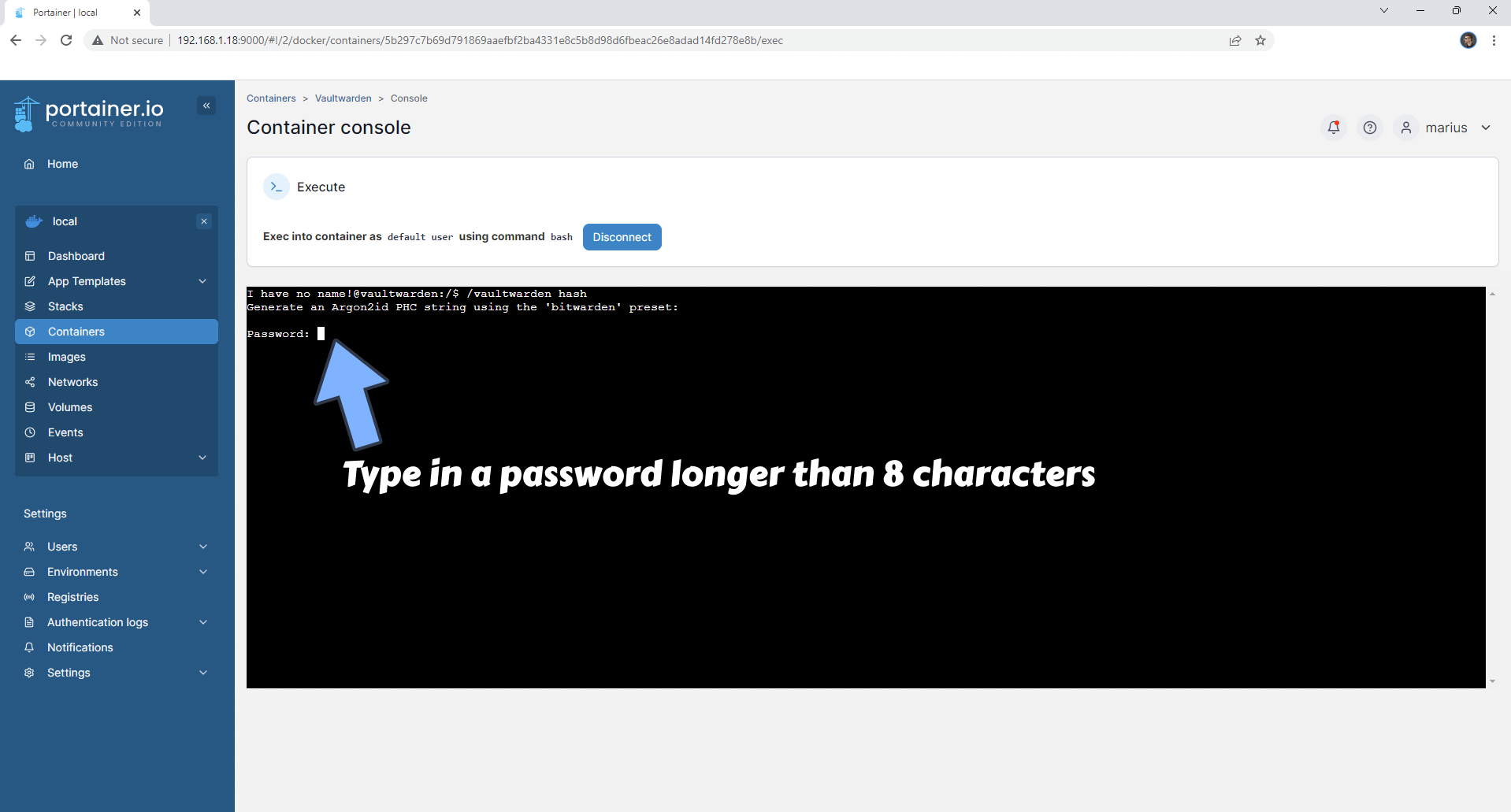
STEP 37
Confirm the password then press Enter on your keyboard. Follow the instructions in the image below.

STEP 38
Copy your token without the ‘ at the beginning and without the ‘ at the end. Save it somewhere because you will need it later at STEP 41.
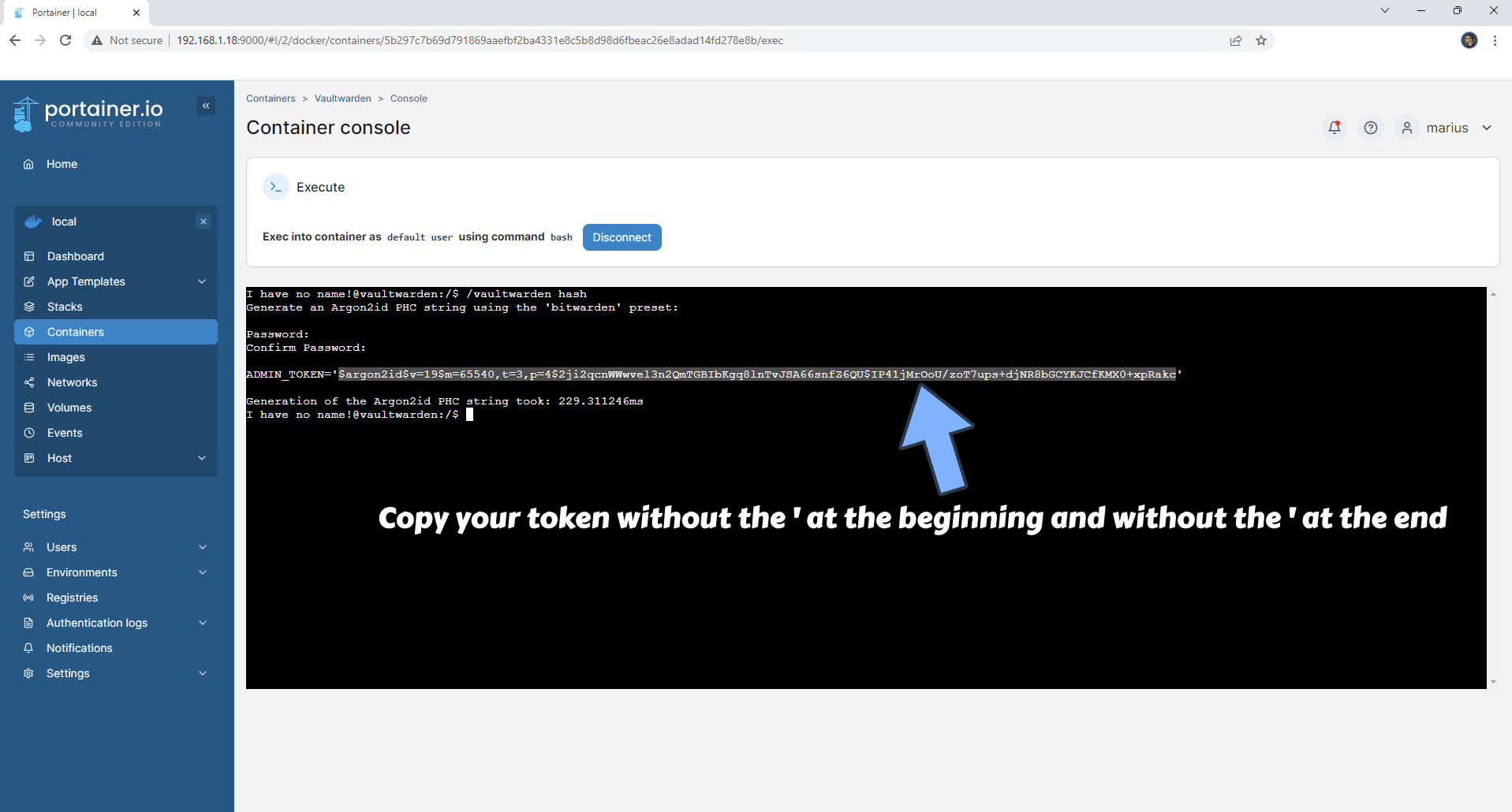
STEP 39
Now open your browser and connect to your own synology.me DDNS address, for example https://vaultwarden.yourname.synology.me/admin You will be asked for an Authentication key. Copy paste your own ADMIN_TOKEN that you have previously created at STEP 14 then click Enter. Follow the instructions in the image below. ⚠️Warning: Paste the token that you have created at STEP 14, NOT the token at STEP 38.
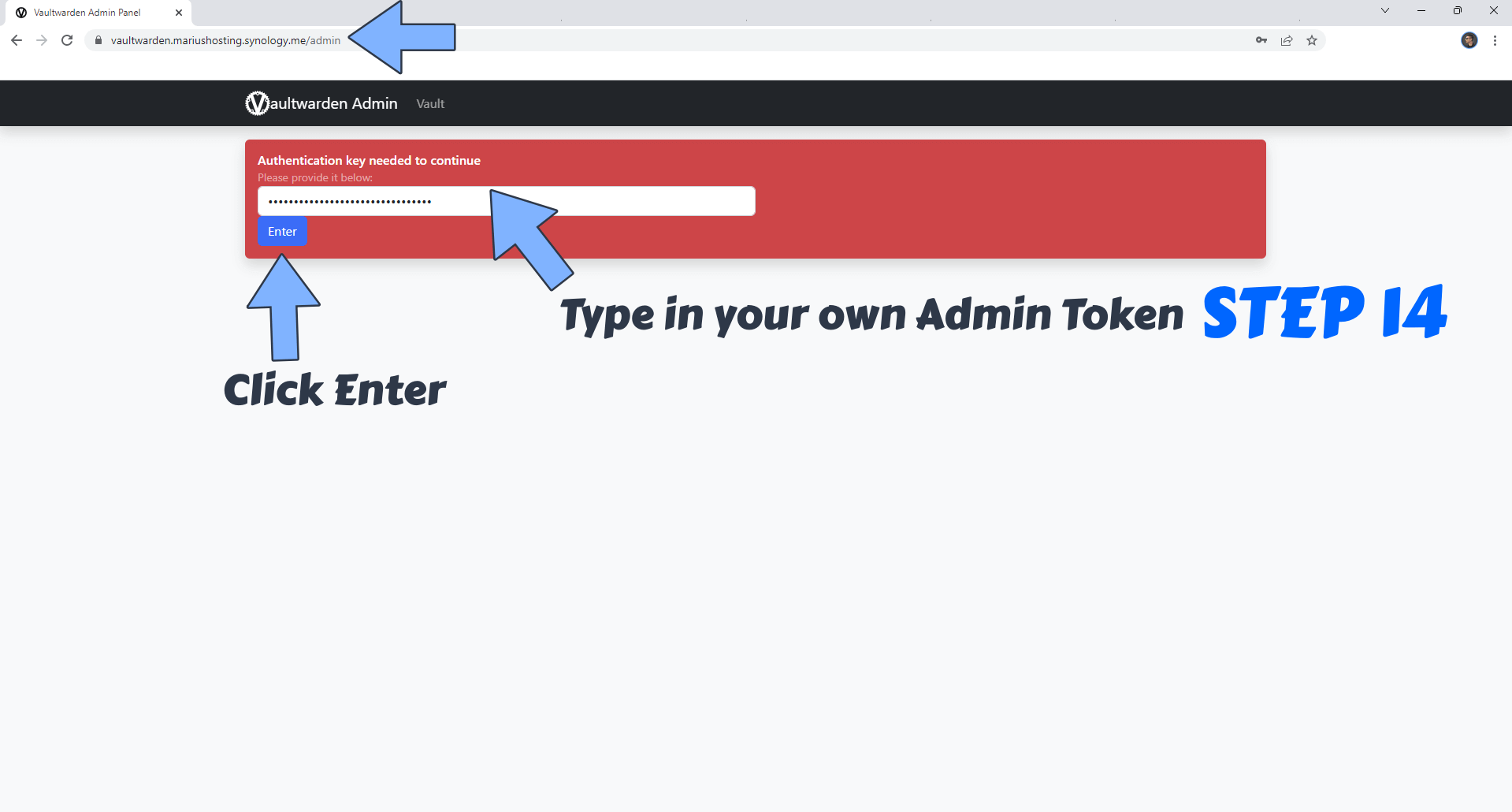
STEP 40
Once you are logged in, click General settings. Follow the instructions in the image below.
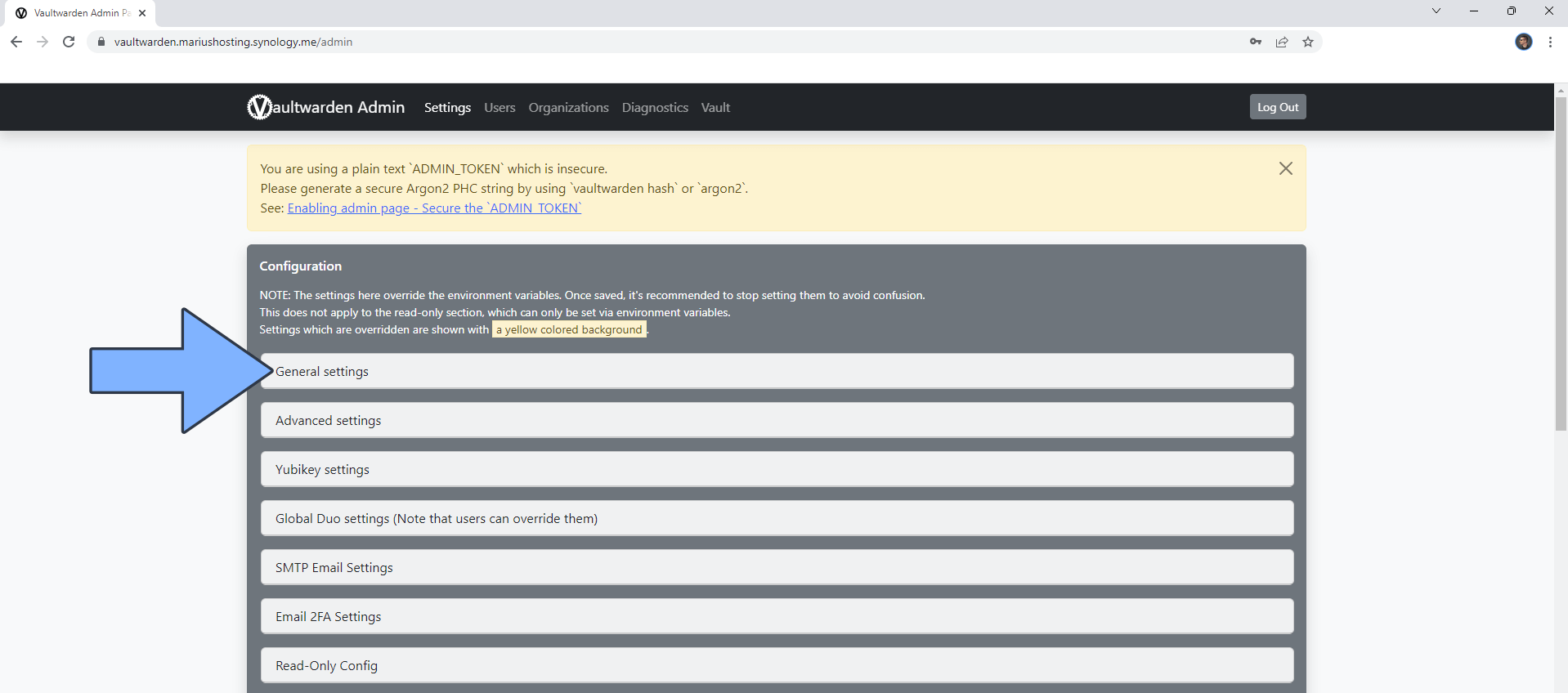
STEP 41
Scroll down the page until you find the Admin page token. In the field, paste your new token that you have previously generated at STEP 38, then click Save. Follow the instructions in the image below.
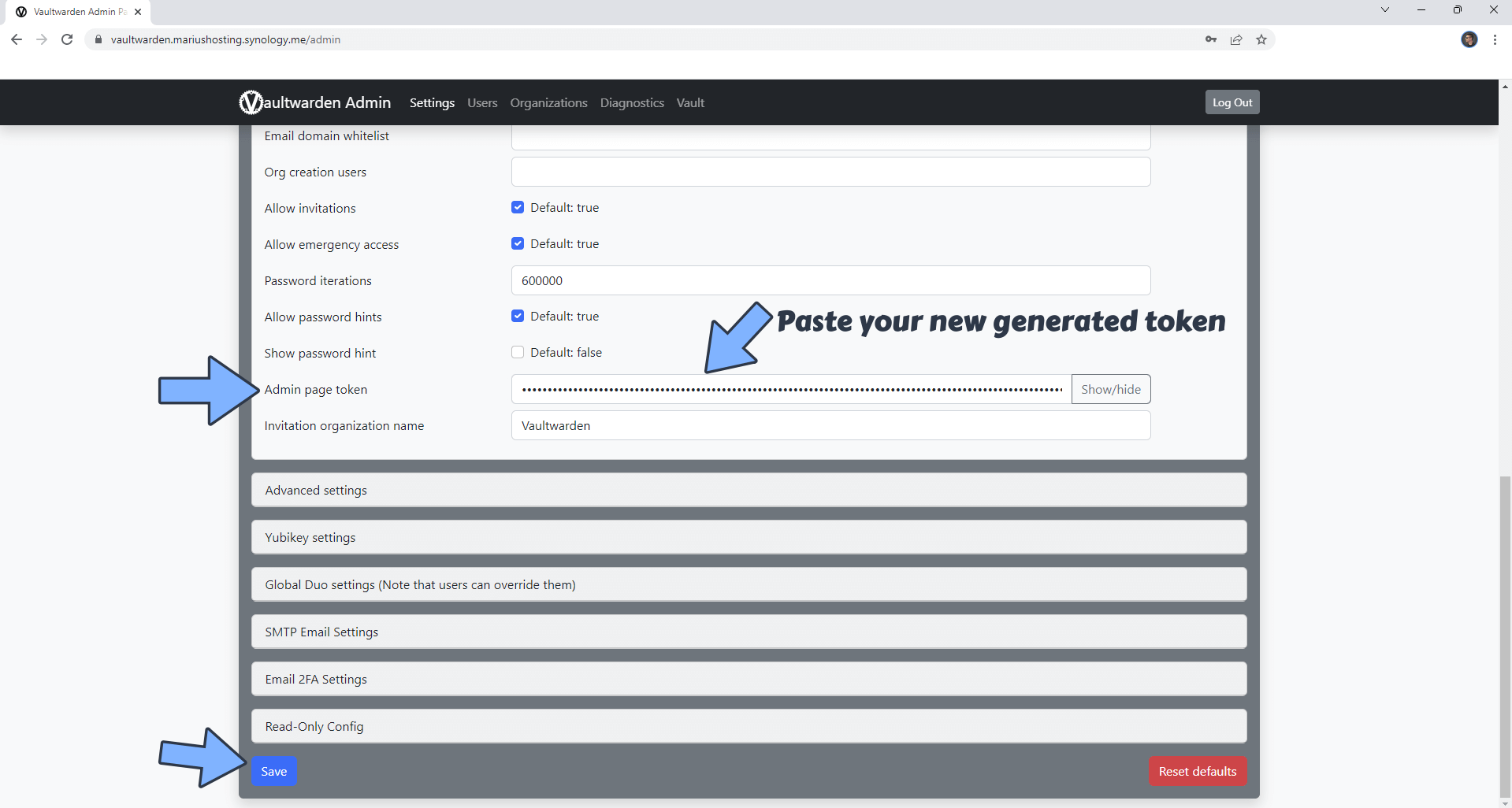
STEP 42
After you click Save, you will get a small pop up window saying “Config saved correctly”. Click OK. Follow the instructions in the image below.

STEP 43
That’s it! The error message notice you were getting is gone. ⚠️Warning: Keep in mind that, when you log in to your Vaultwarden admin page, you need to use the password that you have inserted at STEP 38.
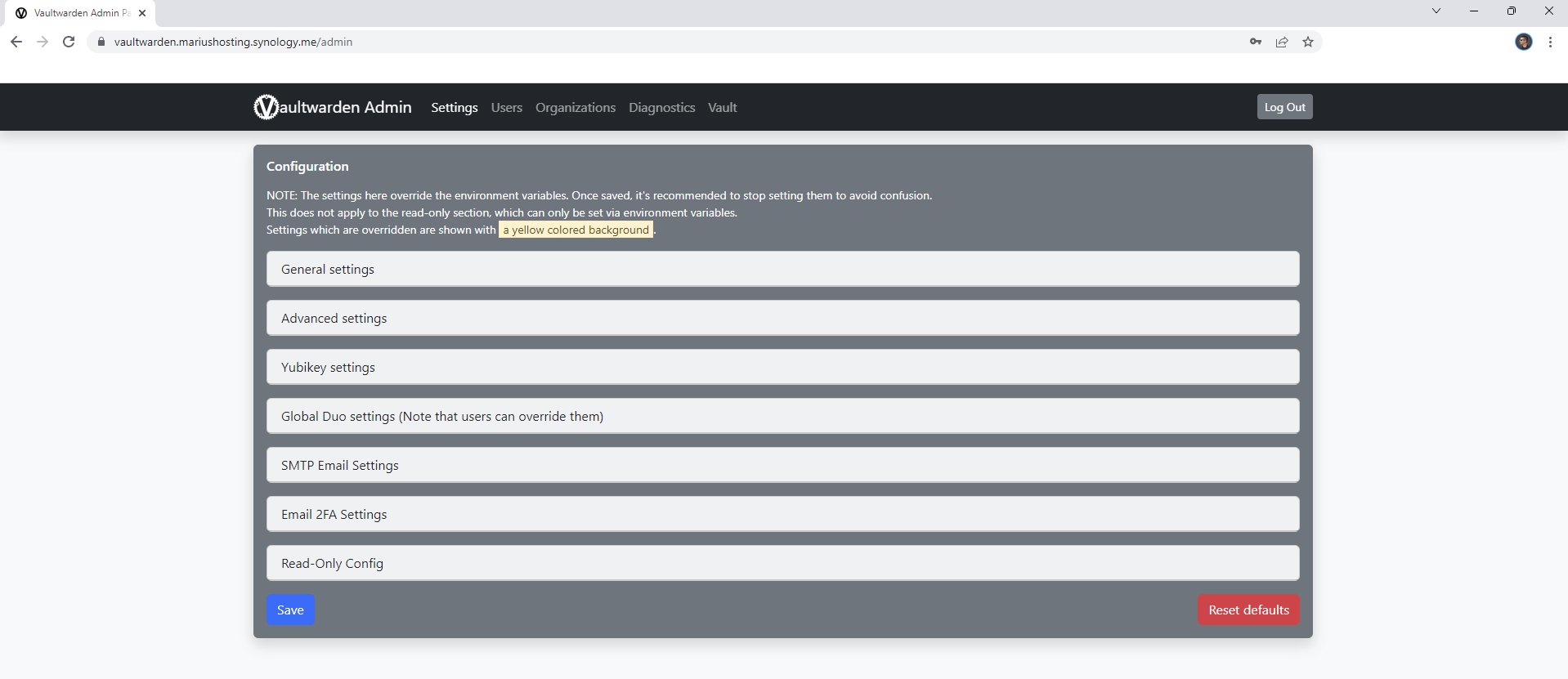
Enjoy Vaultwarden!
If you encounter issues by using this container, make sure to check out the Common Docker issues article.
Note: Can I run Docker on my Synology NAS? See the supported models.
Note: How to Back Up Docker Containers on your Synology NAS.
Note: Find out how to update the Vaultwarden container with the latest image.
Note: How to Free Disk Space on Your NAS if You Run Docker.
Note: How to Schedule Start & Stop For Docker Containers.
Note: How to Activate Email Notifications.
Note: How to Add Access Control Profile on Your NAS.
Note: How to Change Docker Containers Restart Policy.
Note: How to Use Docker Containers With VPN.
Note: Convert Docker Run Into Docker Compose.
Note: How to Clean Docker.
Note: How to Clean Docker Automatically.
Note: Best Practices When Using Docker and DDNS.
Note: Some Docker Containers Need WebSocket.
Note: Find out the Best NAS Models For Docker.
Note: Activate Gmail SMTP For Docker Containers.
This post was updated on Sunday / August 24th, 2025 at 7:43 PM
